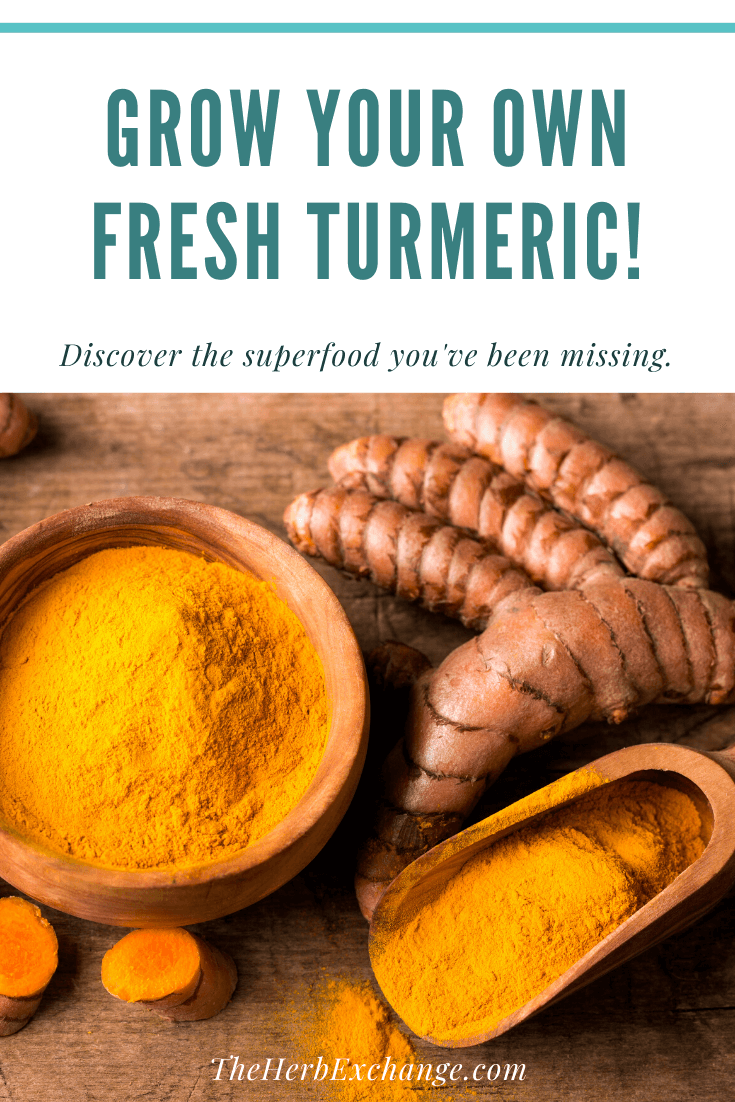You may or may not have heard of turmeric before, or only know about it as a dried spice. However, like many herbs, fresh turmeric is leaps and bounds above it’s dried counterpart. Have you ever dined on Indian food, or perhaps a yellow/orange Thai curry? If you have, chances are you’ve eaten turmeric (Curcuma longa). It is a tropical rhizomatous herbaceous perennial in the ginger family, also related to cardamom.
The bright hues of the fleshy rhizomes contain a chemical compound called curcumin, which also provides many various potential health benefits. Often considered a superfood, turmeric is a staple of Ayurvedic medicine, which dates back thousands of years. The National Center for Complementary and Integrative Health (NIH) considers turmeric generally safe to eat and apply to the skin. And with most anything, moderation is key. High doses may cause gastrointestinal upset.

The benefits of turmeric may include anti-inflammatory, anti-bacterial, and anti-microbial properties. Some people use it as a dietary supplement for arthritis, skin, stomach, liver, and gallbladder problems, rheumatism, fatigue and additional conditions. Before taking any herb for medical purposes, please consult a doctor or reputable herbalist.
Planting & Growing Your Turmeric
It can be challenging to grow turmeric from bare rhizomes and is often best to start with established turmeric plants. Plants may take from 120 to 360 days to mature and can grow 4-5 feet high. It’s straightforward to grow indoors, although allow it to go dormant and let the soil dry out.

Treat turmeric plants as you would any tropical; it needs to be kept at no lower than 65 degrees. It prefers a sunny and warm location, both outdoors or inside. And should be grown indoors in a bright and warm spot during the winter months.
Always plant turmeric in pots with sufficient drainage holes, and maintain a constant, even moisture with regular watering. Much like ginger, the most significant issue to watch out for is root rot. Rot can happen rather quickly with overly soggy soil. So you will need to ensure you don’t overwater the plant or improve drainage. Turmeric plants need a lot of moisture, and they love humidity! Mulching the plants with a thick layer can help with moisture and humidity. Again, make sure not to make the soil too soggy.
Harvesting Your Turmeric Plant
Once your plant is at least six months old, it may take longer, and you can start to collect little bits from the rhizome without hurting the plant. The absolute best time to harvest turmeric is when the leaves have died down, and you can dig up the whole thing, which could take as long as twelve months. Turmeric, along with ginger, is a perfect plant to grow multiples of so you can have many rhizomes to dig up whenever you need it. Tumeric rhizomes can be more finger-like than ginger.

How to Store Turmeric Roots
There are multiple ways to store fresh turmeric roots, including a zippered plastic bag in the freezer or a mesh bag in the refrigerator. This way, you can take out what you need for slicing or grating as required. They can also be boiled, dried, and ground into a powder. Be wary that turmeric can stain clothing, skin, cutting boards, or counters yellow, and so it is best to use non-stainable surfaces & food-safe gloves when handling.
The Many Uses of Turmeric Roots
Turmeric has been a vital part of Ayurvedic medicine for centuries, regarded as an excellent tonic and blood purifier. Commonly referred to as ‘The Golden Healer‘ curcumin is the compound in turmeric responsible for its incredible medicinal effects: potent antioxidant, anti-inflammatory, anti-bacterial, anti-microbial, protective effect on the liver, as well as its positive effect on hardening of the arteries. Many of its traditional medicinal uses are supported by scientific research, and turmeric is gaining in popularity in the West as an important medicinal herb.
Turmeric is a great culinary herb most noted for its thick, branched rhizome, it makes a pungent spice, adding that vibrant golden color to curries. AKA as ‘Indian Saffron’ or ‘Poor Man’s Saffron,’ this wonderful herb is crucial to East Indian, Thai, and Persian cooking. The dried powder is derived from the rhizome and, again, vital in curries. Use it fresh as you would use ginger: stir-fried or pickled! The plant leaves can be used for wrapping and cooking food, and the lovely flowers are edible.

A Simple Fresh Turmeric & Ginger Tea Recipe
Ingredients
- 1.5″ fresh turmeric root, cut to smaller pieces
- 1.5″ fresh ginger root, cut to smaller pieces
- 4 cups filtered water
- lemon to taste
- honey to taste
Directions
- Add turmeric, ginger, water, and lemon (optional) to a pot or saucepan.
- Bring to a boil.
- Strain.
- Serve immediately with extra lemon slices and honey (both optional).
Please note that all information presented is based on the research of the historical uses of the herbs we sell. We are not providing our customers with medical advice, therefore consult a doctor or reputable herbalist before using any herb for medicinal purposes.


Would it be possible for you to supply us with turmeric rhizomes for commercial planting ,or even consulting ? If Possible ,please call John Goni at 661 630 8569 or at 661 343 4816 ,or email as below
I want to get like Rue, Turmeric, and genger rute to plant
What do I need to do to get the free herb Magazine (book)
The flower spray photo is of galangal Team.